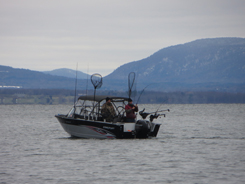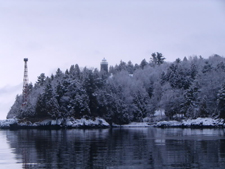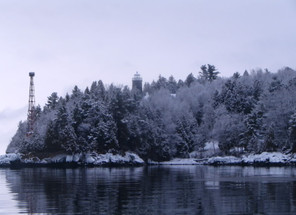Posted by Chris Larsen on 29th Jan 2021
Salmon Fishing on Lake Champlain
When most people think of salmon fishing, they imagine fishing the Great Lakes, the Pacific Northwest, or tributaries. But there’s a not-so-hidden gem on the New York and Vermont border. Lake Champlain is home to a population of landlocked Atlantic salmon. It’s nowhere near the size of  what most people consider prime salmon water, but Lake Champlain is over 500 square miles and has 587 miles of shore. It runs as deep as 400 feet but the average depth of the lake is 64 feet.
what most people consider prime salmon water, but Lake Champlain is over 500 square miles and has 587 miles of shore. It runs as deep as 400 feet but the average depth of the lake is 64 feet.
There is a spirited group of anglers pursuing them. We recently talked to Ron Winter, a Lake Champlain area resident that has been fishing the lake for decades. “It’s a little bit different. Landlocked, unlike Pacific salmon, don’t feed every day. So they can be a very challenging and frustrating fish to fish for. But on the days they do bite they’re very acrobatic. They jump like cohos and steelhead. They’re a very exciting fish to fish for because of that. How do we fish for them? More is better instead of stealth. When we’re trying to create a school of bait with our downriggers and our lite bite slide divers, we’re trying to put a lot out there to attract them so it looks like either an alewife or a smelt.”
 The lake doesn’t fully freeze over so the season starts early. “We’ll start in March or if it’s a late winter, early April. We’re looking for the warmest water, even if it’s only a few degrees in some of the bays… or where some of the creeks and streams come in. We try to find that couple degree difference and troll flatlines or planer boards with small spoons that imitate the smelt and alewife. That progresses into the spring as the water warms up. The fish move down in the column. They like 55 to 60 degrees. We follow them with our Fish Hawk right from the beginning. There’s a lot of current in Lake Champlain. We definitely pay attention to the speed with the spoons we’re using. We use small spoons, 2 ¾”. A lot of guys tape them. As that progresses into summer, we’re chasing the fish down. In June, they’re in 20 to 25 feet. In mid-summer, the fish are down to 70 or 80 feet or as high as 20 or 30 feet depending on the wind and the thermocline.”
The lake doesn’t fully freeze over so the season starts early. “We’ll start in March or if it’s a late winter, early April. We’re looking for the warmest water, even if it’s only a few degrees in some of the bays… or where some of the creeks and streams come in. We try to find that couple degree difference and troll flatlines or planer boards with small spoons that imitate the smelt and alewife. That progresses into the spring as the water warms up. The fish move down in the column. They like 55 to 60 degrees. We follow them with our Fish Hawk right from the beginning. There’s a lot of current in Lake Champlain. We definitely pay attention to the speed with the spoons we’re using. We use small spoons, 2 ¾”. A lot of guys tape them. As that progresses into summer, we’re chasing the fish down. In June, they’re in 20 to 25 feet. In mid-summer, the fish are down to 70 or 80 feet or as high as 20 or 30 feet depending on the wind and the thermocline.”
The bite gets hot in the summer but tails off as salmon start spawning. “The fall is our transition time. The fish are going to be spawning. September is a slow month into mid-October. A lot of the fish are in the streams where they’re spawning and where there is current. It’s very slow. But once we get to frostbite season and the temperatures start cooling again, we’re looking at about 50 degrees by the first of November, the fish start coming out of the streams. The unique thing is landlocked salmon don’t spawn every year. The fish we’re fishing for are the non-spawners from that particular year.”
That “frostbite season” is a favorite for Ron and his friends. “There was a guy that worked in the pool business in the late 1970s. He started this frostbite fishing phenomenon. Basically, he had the winter off... Randy Columbe. He started in  November and fished right through January. The deal is, if you have a bowrider with an enclosed canvas and a Mr. Buddy heater, we like to call it a floating ice shanty. It’s fantastic. That time of year the fishing is tremendous. The fish are up close to the surface but they also can be down 30 or 40 feet. It’s some of the best fishing of the year. This diehard group of fishermen is known as the “frostbite fleet”. We have our own little derby too. We have a trophy like the Stanley Cup for the biggest salmon.”
November and fished right through January. The deal is, if you have a bowrider with an enclosed canvas and a Mr. Buddy heater, we like to call it a floating ice shanty. It’s fantastic. That time of year the fishing is tremendous. The fish are up close to the surface but they also can be down 30 or 40 feet. It’s some of the best fishing of the year. This diehard group of fishermen is known as the “frostbite fleet”. We have our own little derby too. We have a trophy like the Stanley Cup for the biggest salmon.”
While Winter focuses on salmon, there is a strong population of lake trout as well. “There’s a lot of them. Lake trout live forty or fifty years. They’re just exploding on Lake Champlain. You can catch a lot of lake trout. Steelhead, landlocked salmon, and brown trout probably live about five years so there is a smaller pool of them. But the lake trout are exploding and we’ve caught them up to 20 pounds on Lake Champlain.
Ron Winter is a recent guest on the Great Lakes Fishing Podcast. To hear the entire conversation, click the player below or visit our podcast page by clicking here.

